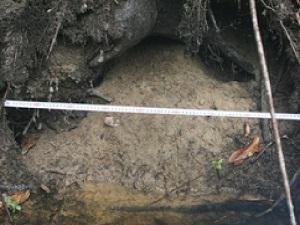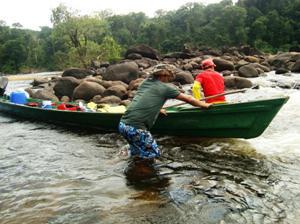Fernanda Michalski
Other projects
31 Jan 2011
Towards a Better Understanding of Conflict Management in Tropical Conservation Units: The Case of Giant Otters and Fishermen in the Northeast Brazilian Amazon
This project aims to deliver baseline data to quantify the distribution and perceptions of otters in riparian corridors across a highly fragmented region of the Brazilian Amazon.

Recently used Giant otter den.
Conserving wildlife species in fragmented landscapes is an immediate challenge facing conservation biologists and managers. One option proposed for mitigating the negative impacts of fragmentation on wildlife is the maintenance of connections between habitat patches. However empirical data on corridor use are still lacking especially for large, bodied mammals. This study aims to fill gaps in ecological understanding and provide a framework for conserving riparian corridors in landscapes dominated by anthropogenic perturbations by monitoring riparian corridor use by giant otters (Pteronura brasiliensis) and neotropical river otters (Lontra longicaudis) in a highly fragmented region of the Brazilian Amazon.

As top predators and charismatic mammals’ otters are recognized as both “umbrella” and “flagship” species. The project will investigate attitudes towards riparian corridors and otters to determine if they can form an effective combination for regional conservation activities.
The project has the specific aims:
- Assess the potential of otters and river corridors as “environmental umbrellas” for regional biodiversity conservation.
- Obtain baseline data which will allow endangered otter population trends to be monitored.
- Quantify the water quality of riparian corridors as water is a crucial link between the environmental and socio-economic importance of riparian corridors.
- Interviews with local landowners will determine presence and absence of otters across the landscape. We will use pre elaborated questionnaires which will also assess the attitudes of local landowners towards riparian corridors and otters. This will enable us to determine their combined effectiveness as umbrellas for regional biodiversity conservation.
We will also survey 15 riparian corridors and five ‘control’ corridors (along perennial streams in continuous forest) to compare the relative abundance of otters. During these surveys we will search for direct and indirect signs of P. brasiliensis and L.longicaudis. These data will enable us to model the spatial distribution of otters in relation to landscape structure. Local landowners value riparian corridors as they are thought to carry clean water. We will survey the water in riparian corridors following established protocols to obtain measurements of water quality. We expect to have better water quality in corridors with more preserved forest which can help landowners to understand the importance of the conservation of riparian forests.
The project is our first step to raise awareness of the conservation of riparian corridors within the local community. The results obtained will generate information on ecological consequences of habitat loss and empirical data on the effectiveness of riparian corridors for otters.